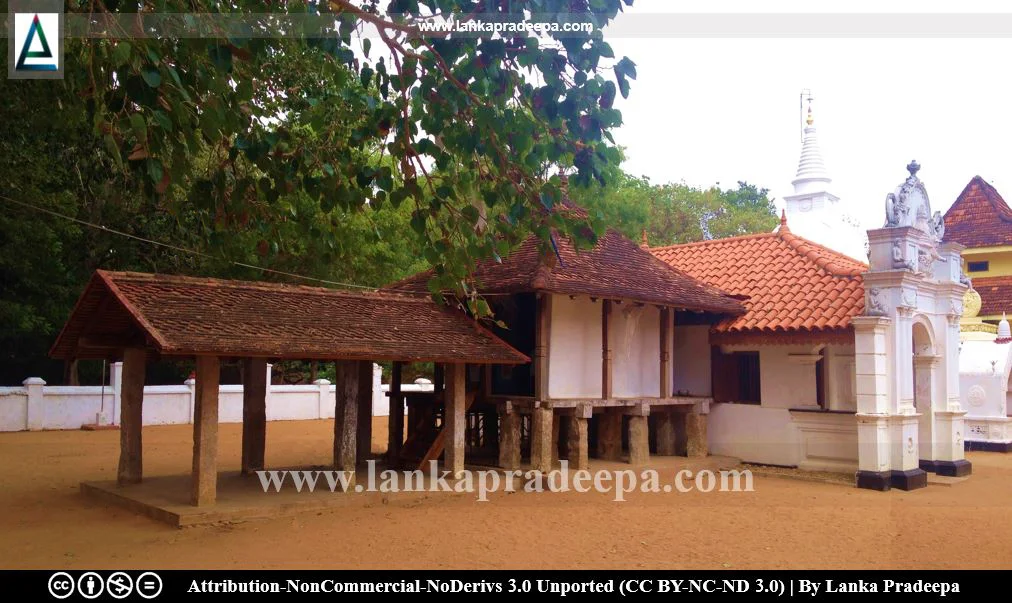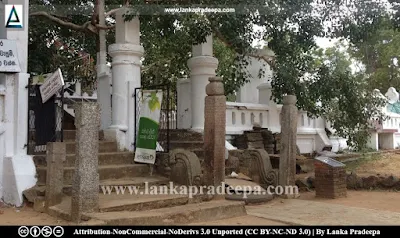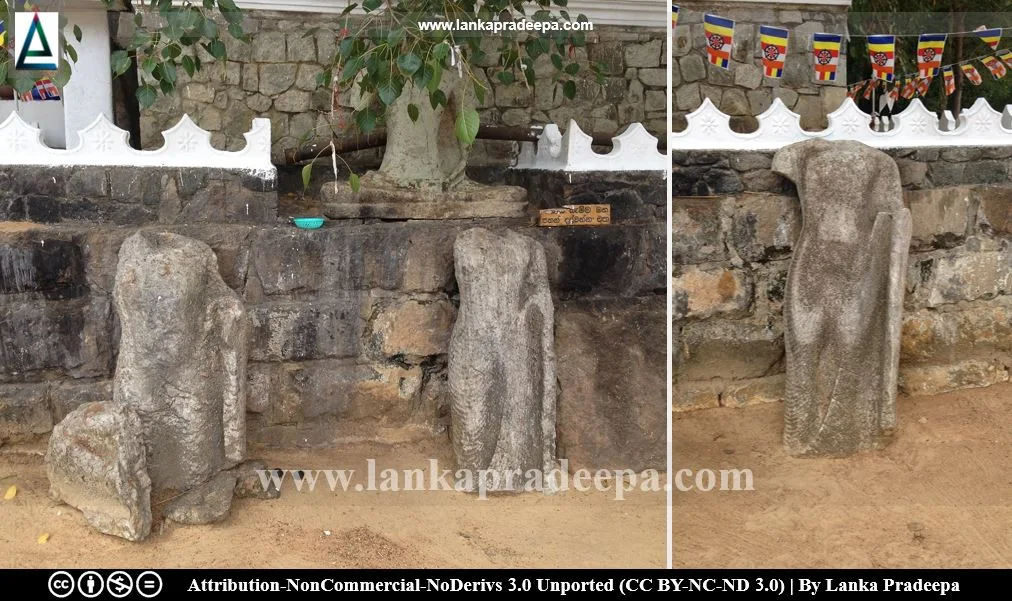
Panduwasnuwara Raja Maha Viharaya, also known as Pandukabhaya Pirivena (Sinhala: පඬුවස්නුවර රජ මහා විහාරය), is a Buddhist temple situated in the Ancient City of Panduwasnuwara in Kurunegala District, Sri Lanka.
History
The temple is situated among the ruins of ancient Parakramapura (presently called Panduwasnuwara), the city of Dakkhinadesa founded by King Parakramabahu the Great (1153-1186 A.D.) when he was the sub-king of this territory (Nicholas, 1963). The temple consists of several old monuments including a Kandyan Era Tempita Vihara, and several pillar inscriptions belonging to the 9-10th century A.D.
Tempita Viharaya
Tempita Viharas (the temples on pillars) were a popular aspect of many Buddhist temples during the Kandyan period. These structures were usually built on a wooden platform resting on bare stone pillars or stumps which are about 1-4 feet tall. The roof is generally made of timber and held by wooden stumps and wattle walls. The walls form the main enclosed shrine room containing Buddhist
sculptures and murals belonging to the Kandyan style. Some Tempita Viharas have narrow verandas and ambulatories circulating the main enclosed space. Construction of these buildings was started in the 17th century and lasted until the end of the 19th century (Wijayawardhana, 2010).
Panduwasnuwara Tempita Viharaya
The Panduwasnuwara Tempita Viharaya is 4.35 m long and 3.75 m wide and has been built upon 16 granite pillars about 3 feet tall (Anulavati & Jayalath, 2011). The entrance door has been placed towards the west and the shrine room can be accessed through a wooden flight of steps. The four-sided roof of the temple is covered with flat clay tiles.
The inside walls of the Tempita Viharaya are adorned with paintings and sculptures belonging to the Kandyan tradition. The main sculpture is a seated Buddha statue in the posture of Bumi-Sparsha Mudra. Two standing images of Buddha are also found on the left and south sides of the shrine room.
In front of the Tempita Viharaya is a Mandapaya about 4.5 m long and 2.55 m wide (Anulavati & Jayalath, 2011). Its two-sided roof is held by 6 granite pillars (Anulavati & Jayalath, 2011).
Pillar inscription near the Bodhi tree of Panduwasnuwara Vihara
 Reign: Udaya II (887-898 A.D.)
Reign: Udaya II (887-898 A.D.)
Period: 9th century A.D.
Script & language: Medieval Sinhala
Content: This records an immunity grant made by the royal officers to the two villages named Nagala and Naranvita of the Kapugama District on the 10th day of the waxing moon in the month of Bak (March-April) during the 7th regnal year of King Udaya II. Also includes a decree preventing royal officers on state duty from entering the villages.
Reference: The information board at the site by the Department of Archaeology and the Ministry of National Heritage.
Panduwasnuwara pillar inscription of Dappula IV
This inscription has been brought to the temple from a place nearby sometime before the year 1912 (Ranawella, 2004). The four-sided pillar is 6.5 ft high and its capital ends with a vase-shaped carving (Ranawella, 2004). The writing is found on all four sides of the pillar.
Inscriptions
Several stone pillars with inscriptions belonging to the 9-10th centuries A.D. have been unearthed from the premises of Panduwasnuwara Raja Maha Viharaya and from the surrounding areas. The inscriptions have been dated by scholars to the reigns of King Sena II (853-887 A.D.), King Udaya II (887-898 A.D.), King Kassapa IV (898-915 A.D.), King Kassapa V (915-923 A.D.), King Dappula IV (923-935 A.D.), and King Nissankamalla [(1187-1196 A.D) Ranawella, 2001; Ranawella, 2004; Ranawella, 2005; Ranawella, 2007]. The reigns of some of the inscriptions are still to be identified (Ranawella, 2005).Pillar inscription near the Bodhi tree of Panduwasnuwara Vihara
 Reign: Udaya II (887-898 A.D.)
Reign: Udaya II (887-898 A.D.)Period: 9th century A.D.
Script & language: Medieval Sinhala
Content: This records an immunity grant made by the royal officers to the two villages named Nagala and Naranvita of the Kapugama District on the 10th day of the waxing moon in the month of Bak (March-April) during the 7th regnal year of King Udaya II. Also includes a decree preventing royal officers on state duty from entering the villages.
Reference: The information board at the site by the Department of Archaeology and the Ministry of National Heritage.
Panduwasnuwara pillar inscription of Dappula IV
This inscription has been brought to the temple from a place nearby sometime before the year 1912 (Ranawella, 2004). The four-sided pillar is 6.5 ft high and its capital ends with a vase-shaped carving (Ranawella, 2004). The writing is found on all four sides of the pillar.
Reign: Dappula IV (923-935 A.D.)
Period: 10th century A.D.
Script & language: Medieval Sinhala
Content:
This inscription records some grant of immunities by a Mahapa named Uda (Udaya) in respect of some lands owned by a monastery named Salameyvan-raj Kapugam Pirivena situated in a region named Riha-bima of the Southern Quarter and affiliated to the Maha Viharaya (in Anuradhapura)
References: Ranawella, 2004.



.
References: Ranawella, 2004.
A protected site
The Dalada Maligawa (the Temple of the Tooth) building located in Panduwasnuwara Raja Maha Vihara premises in the
Divisional Secretary’s Division, Hettipola is an archaeological protected monument, declared by a government Gazette notification published on 13 March 1970.



.
References
1) Anulavati, K.M., Jayalath, V., 2011. Panduwasnuwara; Parakramapura (In Sinhala). Department of Archaeology. ISBN: 978-955-9159-73-5. pp.16-17.2) Nicholas, C. W., 1963. Historical topography of ancient and medieval Ceylon. Journal of the Ceylon Branch of the Royal Asiatic
Society, New Series (Vol VI). Special Number: Colombo. Royal Asiatic
Society (Ceylon Branch). p.104.
3) Ranawella, S., 2001. Inscription of Ceylon. Volume V, Part I. Department of Archaeology. ISBN: 955-9159-21-6. pp.24-25,138-143,228-230,351-357.
3) Ranawella, S., 2001. Inscription of Ceylon. Volume V, Part I. Department of Archaeology. ISBN: 955-9159-21-6. pp.24-25,138-143,228-230,351-357.
4) Ranawella, G.S., 2004. Inscription of Ceylon. Volume V, Part
II. Department of Archaeology. ISBN: 955-9159-30-5. pp.90-92.
5) Ranawella, S., 2005. Inscription of Ceylon. Volume V, Part
III. Department of Archaeology. ISBN: 955-91-59-57-7. pp.2,13-14,111.
6) Ranawella, S., 2007. Inscription of Ceylon. Volume VI. Department of Archaeology. ISBN: 978-955-91-59-61-2. p.196.
6) Ranawella, S., 2007. Inscription of Ceylon. Volume VI. Department of Archaeology. ISBN: 978-955-91-59-61-2. p.196.
7) Wijayawardhana, K., 2010. Sri Lankawe Tampita Vihara (In Sinhala). Dayawansa Jayakody & Company. Colombo. ISBN: 978-955-551-752-2. p. 12.
8) The Gazette of the Democratic Socialist Republic of Sri Lanka. No: 14897. 13 March 1970.
Location Map
This page was last updated on 14 January 2023

